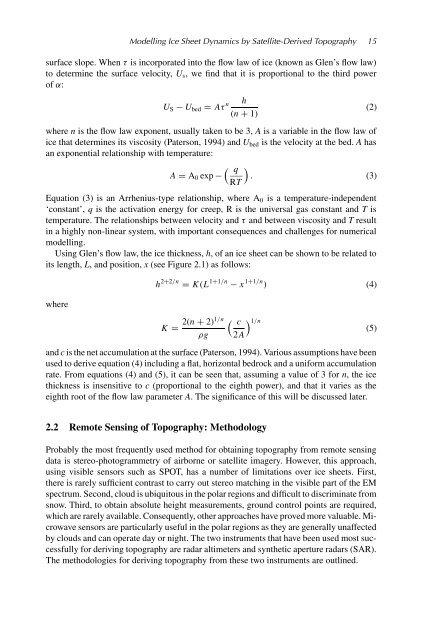1 Spatial Modelling of the Terrestrial Environment - Georeferencial
1 Spatial Modelling of the Terrestrial Environment - Georeferencial
1 Spatial Modelling of the Terrestrial Environment - Georeferencial
Create successful ePaper yourself
Turn your PDF publications into a flip-book with our unique Google optimized e-Paper software.
<strong>Modelling</strong> Ice Sheet Dynamics by Satellite-Derived Topography 15<br />
surface slope. When τ is incorporated into <strong>the</strong> flow law <strong>of</strong> ice (known as Glen’s flow law)<br />
to determine <strong>the</strong> surface velocity, U s ,wefind that it is proportional to <strong>the</strong> third power<br />
<strong>of</strong> α:<br />
U S − U bed = Aτ n h<br />
(2)<br />
(n + 1)<br />
where n is <strong>the</strong> flow law exponent, usually taken to be 3, A is a variable in <strong>the</strong> flow law <strong>of</strong><br />
ice that determines its viscosity (Paterson, 1994) and U bed is <strong>the</strong> velocity at <strong>the</strong> bed. A has<br />
an exponential relationship with temperature:<br />
( q<br />
)<br />
A = A 0 exp − . (3)<br />
RT<br />
Equation (3) is an Arrhenius-type relationship, where A 0 is a temperature-independent<br />
‘constant’, q is <strong>the</strong> activation energy for creep, R is <strong>the</strong> universal gas constant and T is<br />
temperature. The relationships between velocity and τ and between viscosity and T result<br />
in a highly non-linear system, with important consequences and challenges for numerical<br />
modelling.<br />
Using Glen’s flow law, <strong>the</strong> ice thickness, h, <strong>of</strong> an ice sheet can be shown to be related to<br />
its length, L, and position, x (see Figure 2.1) as follows:<br />
where<br />
h 2+2/n = K (L 1+1/n − x 1+1/n ) (4)<br />
K =<br />
2(n + 2)1/n<br />
ρg<br />
( c<br />
) 1/n<br />
(5)<br />
2A<br />
and c is <strong>the</strong> net accumulation at <strong>the</strong> surface (Paterson, 1994). Various assumptions have been<br />
used to derive equation (4) including a flat, horizontal bedrock and a uniform accumulation<br />
rate. From equations (4) and (5), it can be seen that, assuming a value <strong>of</strong> 3 for n, <strong>the</strong> ice<br />
thickness is insensitive to c (proportional to <strong>the</strong> eighth power), and that it varies as <strong>the</strong><br />
eighth root <strong>of</strong> <strong>the</strong> flow law parameter A. The significance <strong>of</strong> this will be discussed later.<br />
2.2 Remote Sensing <strong>of</strong> Topography: Methodology<br />
Probably <strong>the</strong> most frequently used method for obtaining topography from remote sensing<br />
data is stereo-photogrammetry <strong>of</strong> airborne or satellite imagery. However, this approach,<br />
using visible sensors such as SPOT, has a number <strong>of</strong> limitations over ice sheets. First,<br />
<strong>the</strong>re is rarely sufficient contrast to carry out stereo matching in <strong>the</strong> visible part <strong>of</strong> <strong>the</strong> EM<br />
spectrum. Second, cloud is ubiquitous in <strong>the</strong> polar regions and difficult to discriminate from<br />
snow. Third, to obtain absolute height measurements, ground control points are required,<br />
which are rarely available. Consequently, o<strong>the</strong>r approaches have proved more valuable. Microwave<br />
sensors are particularly useful in <strong>the</strong> polar regions as <strong>the</strong>y are generally unaffected<br />
by clouds and can operate day or night. The two instruments that have been used most successfully<br />
for deriving topography are radar altimeters and syn<strong>the</strong>tic aperture radars (SAR).<br />
The methodologies for deriving topography from <strong>the</strong>se two instruments are outlined.

















